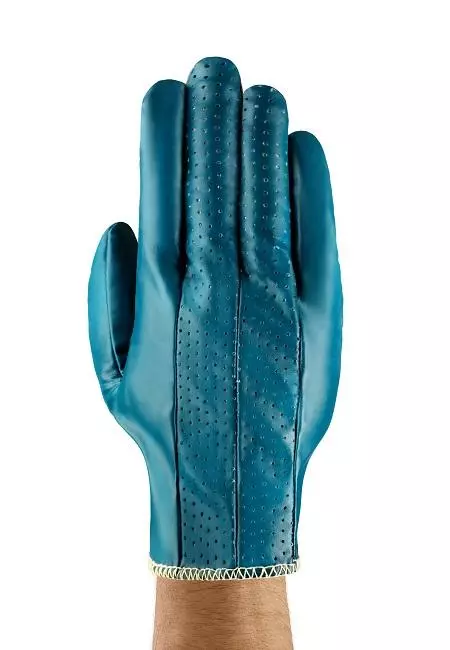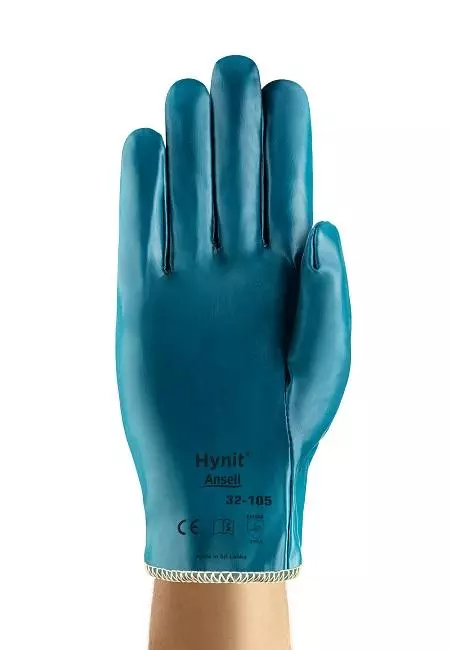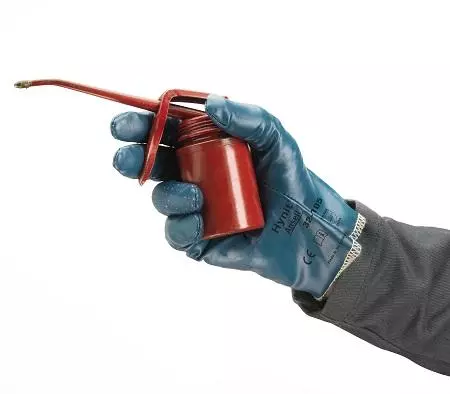Ansell Hynit 32-125
Ansell
visit storeProduct description
Description
Special nitrile formulation unites excellent resistance to abrasion with remarkable flexibility
Recommended for
Assembly & inspection of components
Delivery of parts to production line
Seizing structural parts
Loading and unloading rough parts or boxes
Final assembly
Handling application & cleaning tools
Shipping and loading of product
Product Details
Antistatic : Yes
Length : 208-237 Mm/8.2-9.3 Inches
Available Sizes : 6.5, 7, 7.5, 8, 9, 10
Coating Color : Blue
Coating Material : Nitrile
Construction : Cut & Sewn
Cuff Style : Slip-On - Perforated Back
Finishing : Fully Impregnated
Gauge : N/A
Liner Color : Off White
Liner Material : Cotton, Polyester
Silicone Free : No
Specific Needs : Food
Washing Temperature : 40 °C (104 °F)
Multi-purpose design offers versatile protection and comfort, ready for a wide range of tasks.
Precisely cut and sewn for a tailored fit, these gloves provide enhanced dexterity and lasting comfort.
Full finger coverage offers complete protection and warmth, keeping your hands safe and comfortable.
Indicates which areas of the glove have protective or grip-enhancing coating applied, affecting durability, grip, and dexterity in different work tasks.
Determines how the glove secures around the wrist, affecting fit, protection from debris, and ease of putting gloves on and taking them off.
The material applied to glove surfaces to enhance grip, protection, and durability for specific work conditions and hazards.
- Cut Resistant
- Food Service
- Machine Washable
- Hand Protection
Request a free sample
Test first and buy later. Visit any product page to request your free sample.
Standards and labels
Test results
General Requirements GuideEN ISO 21420:2020 is a standard that outlines general requirements and guidelines for protective gloves, aiming to ensure their quality, performance, and suitability for various applications. When a product meets the requirements outlined in the General Requirements section of EN ISO 21420:2020, it signifies that the gloves comply with fundamental quality and performance criteria, including factors such as size, fit, ergonomics, and dexterity. The practical implications of this compliance are significant, as it assures users of the gloves' basic functionality and suitability for general hand protection purposes across a range of industries and applications. The test method involves evaluating various aspects of the gloves, including dimensions, construction, materials, and labeling, to ensure conformity with the specified requirements. Compliance with these general requirements enhances user confidence in the protective gloves' reliability and effectiveness, promoting workplace safety and facilitating compliance with regulatory standards.
EN 388:2016 is a European standard for measuring the performance of protective gloves against mechanical risks (abrasion, cut, tear, and puncture). The standard includes test methods and performance requirements for gloves to be considered compliant. Test results are reported using a series of four numbers, each representing the performance level achieved in one of the tests.
Test results
Cut Resistance, ISO 13997 Level AThe cut resistance result of Level A based on ISO 13997 in the standard EN 388:2016 indicates a force of greater than 2 Newtons required to cut through the material. This is considered the first level on a scale that ranges up to Level F, where each level corresponds to higher thresholds of force needed to penetrate the material, with Level F exceeding 30 Newtons. The testing method employs a TDM test device equipped with a single-use straight edge blade. During the test, the blade is drawn only once across the material in one direction, and once the blade cuts through the sample, the distance the blade has traveled is recorded. This standardized testing ensures that the cut resistance of materials like gloves can be measured more accurately, especially those fabricated from high-cut resistance materials that might blunt a blade. The practical implication of obtaining a result of Level A in this test is that the material provides basic cut protection and is suitable for tasks with minimal cut hazards, such as light material handling or small parts assembly.
Abrasion Resistance Level 3EN 388:2016 is a European standard that provides guidelines for assessing the protection levels of gloves against mechanical risks, such as abrasion, cuts, tears, and puncture. The Abrasion Resistance Level 3 indicates a higher level of protection, signifying that the gloves can resist more intensive wear from rough materials. According to the standard, the abrasion resistance test involves rubbing the glove material against sandpaper under a specified pressure until it is worn through. Level 3 abrasion resistance requires that the gloves withstand 2000 to 7999 cycles of abrasion. This enhanced level of durability is appropriate for tasks involving more frequent or more intense contact with abrasive surfaces, such as construction work, woodworking, and handling building materials. Gloves with Level 3 abrasion resistance offer a robust barrier against wear, extending glove life and providing increased protection for the wearer’s hands, thus reducing the risk of injuries in more demanding work environments.
Cut Resistance, Coup Test Level 1The EN 388:2016 standard is dedicated to gauging the mechanical risks for hand protection where a Cut Resistance, Coup Test Level 1 indicates minimal resistance to cutting because material achieved between 1.2 and 2.5 cycles before being cut through during the test. It means that the product tested at this level offers basic protection against shallow cuts, suitable for tasks with low risk of cut injuries. The test method used involves a rotating circular blade under a fixed force making contact with the fabric or material being tested. The blade moves back and forth across the material until a cut-through is achieved. The number of cycles required to cut through the sample at a consistent speed determines the cut resistance, with Level 1 being the second lowest rating after level 0. Products at this level are applicable in scenarios where there are minimal hazards from sharp objects, hence ideal for light duties where there is no significant risk of deep cuts.
Tear Resistance Level 1EN 388:2016 is a European standard that outlines the testing requirements for gloves to determine their level of protection against mechanical hazards, including tear resistance. The Tear Resistance Level 1 classification signifies that the gloves offer basic protection against tearing. The test method involves applying a force to a sample of the glove material to tear it, and the force measured reflects the glove's ability to resist tearing. Level 1 tear resistance means the gloves can withstand a force of between 10 to 25 Newtons before tearing. This basic level of protection is suitable for tasks where there is a minimal risk of tearing due to light manual handling or where gloves are used to prevent scratches or minor abrasions. Gloves with Level 1 tear resistance are appropriate for general activities that do not involve handling sharp or jagged materials.
Puncture Resistance Level 1The European standard EN 388:2016 addresses the puncture resistance of protective gloves, with puncture resistance classified from Levels 1 to 4. Specifically, a Level 1 result indicates minimal puncture resistance. This level of resistance is determined by a test involving a standardized stylus with a specified diameter and force. During the test, the stylus is pressed against the material with a force up to 20 Newtons to assess how well the glove can withstand penetration. A Level 1 rating signifies that the glove provides basic protection against small punctures or stabs, appropriate for areas with minimal risk. Practical implications for this test result suggest the gloves are suitable for light tasks where major risks of punctures are not anticipated, but are not adequate for handling sharp tools or heavy equipment where higher penetration resistance would be necessary.
CE Marking is a label that shows a product meets certain safety and environmental standards set by the European Union. To get the CE Marking, a company must test and certify their product meets these standards. CE Marking is required for many products sold in the EU, including electronics, machinery, toys and medical devices. It helps ensure that products are safe for consumers and the environment, and allows for easy trade within the EU.
Food safe refers to the safety of food products that are used or consumed by people. In Europe, food safety is regulated by the European Union (EU) and the European Food Safety Authority (EFSA). These organizations set standards and requirements for food products to ensure they are safe to eat. To be considered "food safe" in Europe, a product must meet these standards and be free of harmful substances. This includes being free of harmful bacteria, pesticides, and other contaminants. Food products that do not meet these standards cannot be sold or used in the EU.
PPE stands for "personal protective equipment." PPE Category 2 refers to equipment that is more complex, and has a higher level of risk. Examples of PPE Category 2 include safety helmets, ear protection, and fall arrest equipment. In Europe, PPE Category 2 must meet certain safety standards set by the European Union, which means that it must be designed and manufactured to protect the user without causing harm. Companies that make or sell PPE must prove that it meets these standards. They also must have a quality management system in place and have to be audited regularly by a notified body.
Ecovadis rating and certification system is used in Europe to evaluate and recognize companies' sustainability performance. It is focused on the supply chain and evaluates companies on environmental, social and ethical criteria, such as environmental protection, labor practices, and fair business practices. The requirements for getting an Ecovadis certification will depend on the specific category of business and industry, but typically include providing information on the company's sustainability practices, policies and performance, and undergoing an assessment by an independent auditor.
REACH stands for "Registration, Evaluation, Authorisation and Restriction of Chemicals" it is a regulation of the European Union that governs the registration, evaluation, authorization, and restriction of chemicals. The REACH regulation aims to ensure that the chemicals used in Europe are safe for human health and the environment. The regulation applies to all chemical substances, whether they are used in industrial processes or in everyday products such as cleaning products, paints, and cosmetics. Companies that manufacture, import or use chemicals in the EU must register the chemicals they produce or import, provide safety information and communicate the risks associated with the chemicals. This information will be used to assess the risks and determine if any further action is needed to protect human health and the environment.
Ansell delivery terms
Free delivery for all Ansell products
325,17 €
Price per 12 packages (144 pairs)
2,26 € / pair
Free delivery
A carton contains 12 packages (144 pairs)
Need larger quantities?
Other products you may like
Recently viewed
Need help?
Get help from our experts
Other products you may like
Similar products you may like
Autonomous sourcing platform
The most efficient way to source and order supplies for your operations
Sourcing
Ordering
List products you’re looking for and we’ll find the best products and prices for you – all for free.
Need help?
Get help from our experts





